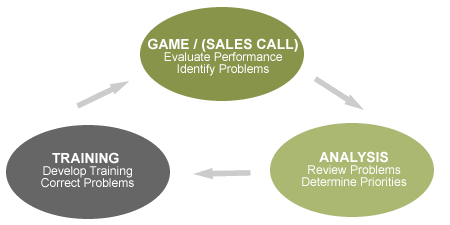Although I love my job, I am most passionate about coaching soccer. In fact, if you speak to me for more than five minutes, at some point I will probably figure out a way to bring soccer into the conversation.
During more than 10 years of coaching boys and girls at both the recreational and club level, I have learned that the development cycle of a good soccer player is no different than the development cycle of a good sales person.

GAME / SALES CALL
There is no substitute for an actual competitive game or sales call to evaluate the strengths and weaknesses of a player or salesperson. Unfortunately, too many sales managers make two mistakes.
- The first mistake is not consistently going with their salespeople on joint sales calls. You can’t expect what you don’t inspect. In other words, you can’t possibly identify each team members’ problem areas without observing them first hand in the field (or on the phone). Not only that, you can’t possibly determine if the sales training you’re implementing is being carried out in the field.
- The other common mistake is taking over the call – I’m guilty of this. I struggle when I observe mistakes taking place to constantly yell out instructions. However, if you do the call for salesperson, they become reliant upon you. In addition, you will have lost the opportunity to assess their performance. You may lose a sale or two, but in the long run, you’ll have a salesperson that you can be confident will know what to do especially when you’re not present.
*Quick Tip: One of the best ways to prevent you from taking over a call is to bring with you an evaluation worksheet. You’ll be more preoccupied with the evaluation, and less with winning the sale. By the way, if you coach a soccer team and struggle with over- coaching always bring a chair and try not to get up from it.
ANALYSIS
After you observe your salesperson’s performance, the next step is to conduct an analysis. The first part is to review the problems with your salesperson. Don’t make the mistake of trying to change everything all at once, but identify no more than three areas that need improvement.
You should conduct this review immediately after the call while it is still fresh. Start by asking your salesperson, “How do you feel the call went?” You can then follow up with, “Why, or why not?” After they provide you their assessment, you can then share your observations. You may very well find out, they are already aware of their problems.
After the review, determine the three biggest priorities that need to be addressed. Not only are identifying more than three problem areas disheartening, but it’s also not realistic to try to change everything overnight.
TRAINING
You’ve observed your salesperson in action, you’ve analyzed their performance, and now you need to correct the negatives and reinforce the positives. This is best done in a risk free, less stress environment.
Whether it’s in a sales meeting or in a one on one coaching session, take the priorities that you identified, and develop a training curriculum that addresses these issues. The session should first identify what a positive outcome would look like, and the steps necessary to achieve this outcome. This might be in the form of a role playing session.
Once you have completed each step in the developmental cycle, you need to repeat it, in order to effectively develop each team member. As a sales manager, one of your primary jobs is to continually develop each salesperson regardless of their experience level. When you fail to do this, you can’t fault your salespeople for falling short of their sales goals.

